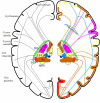A thalamic reticular networking model of consciousness
- PMID: 20353589
- PMCID: PMC2857829
- DOI: 10.1186/1742-4682-7-10
A thalamic reticular networking model of consciousness
Abstract
[BACKGROUND]: It is reasonable to consider the thalamus a primary candidate for the location of consciousness, given that the thalamus has been referred to as the gateway of nearly all sensory inputs to the corresponding cortical areas. Interestingly, in an early stage of brain development, communicative innervations between the dorsal thalamus and telencephalon must pass through the ventral thalamus, the major derivative of which is the thalamic reticular nucleus (TRN). The TRN occupies a striking control position in the brain, sending inhibitory axons back to the thalamus, roughly to the same region where they receive afferents. [HYPOTHESES]: The present study hypothesizes that the TRN plays a pivotal role in dynamic attention by controlling thalamocortical synchronization. The TRN is thus viewed as a functional networking filter to regulate conscious perception, which is possibly embedded in thalamocortical networks. Based on the anatomical structures and connections, modality-specific sectors of the TRN and the thalamus appear to be responsible for modality-specific perceptual representation. Furthermore, the coarsely overlapped topographic maps of the TRN appear to be associated with cross-modal or unitary conscious awareness. Throughout the latticework structure of the TRN, conscious perception could be accomplished and elaborated through accumulating intercommunicative processing across the first-order input signal and the higher-order signals from its functionally associated cortices. As the higher-order relay signals run cumulatively through the relevant thalamocortical loops, conscious awareness becomes more refined and sophisticated. [CONCLUSIONS]: I propose that the thalamocortical integrative communication across first- and higher-order information circuits and repeated feedback looping may account for our conscious awareness. This TRN-modulation hypothesis for conscious awareness provides a comprehensive rationale regarding previously reported psychological phenomena and neurological symptoms such as blindsight, neglect, the priming effect, the threshold/duration problem, and TRN-impairment resembling coma. This hypothesis can be tested by neurosurgical investigations of thalamocortical loops via the TRN, while simultaneously evaluating the degree to which conscious perception depends on the severity of impairment in a TRN-modulated network.
Figures


Similar articles
-
Visual Deprivation Selectively Reduces Thalamic Reticular Nucleus-Mediated Inhibition of the Auditory Thalamus in Adults.J Neurosci. 2022 Oct 19;42(42):7921-7930. doi: 10.1523/JNEUROSCI.2032-21.2022. Epub 2022 Sep 7. J Neurosci. 2022. PMID: 36261269 Free PMC article.
-
Functional organization of the thalamic input to the thalamic reticular nucleus.J Neurosci. 2011 May 4;31(18):6791-9. doi: 10.1523/JNEUROSCI.3073-10.2011. J Neurosci. 2011. PMID: 21543609 Free PMC article.
-
Auditory thalamic reticular nucleus of the rat: anatomical nodes for modulation of auditory and cross-modal sensory processing in the loop connectivity between the cortex and thalamus.J Comp Neurol. 2012 May 1;520(7):1457-80. doi: 10.1002/cne.22805. J Comp Neurol. 2012. PMID: 22101990
-
Thalamic reticular nucleus in the thalamocortical loop.Neurosci Res. 2020 Jul;156:32-40. doi: 10.1016/j.neures.2019.12.004. Epub 2019 Dec 5. Neurosci Res. 2020. PMID: 31812650 Review.
-
Thalamic contributions to the state and contents of consciousness.Neuron. 2024 May 15;112(10):1611-1625. doi: 10.1016/j.neuron.2024.04.019. Neuron. 2024. PMID: 38754373 Free PMC article. Review.
Cited by
-
Synthetic consciousness architecture.Front Robot AI. 2024 Nov 28;11:1437496. doi: 10.3389/frobt.2024.1437496. eCollection 2024. Front Robot AI. 2024. PMID: 39669909 Free PMC article.
-
The evolutionary and genetic origins of consciousness in the Cambrian Period over 500 million years ago.Front Psychol. 2013 Oct 4;4:667. doi: 10.3389/fpsyg.2013.00667. eCollection 2013. Front Psychol. 2013. PMID: 24109460 Free PMC article.
-
How the cortico-thalamic feedback affects the EEG power spectrum over frontal and occipital regions during propofol-induced sedation.J Comput Neurosci. 2015 Oct;39(2):155-79. doi: 10.1007/s10827-015-0569-1. Epub 2015 Aug 11. J Comput Neurosci. 2015. PMID: 26256583
-
Therapeutic Neuromodulation toward a Critical State May Serve as a General Treatment Strategy.Biomedicines. 2022 Sep 18;10(9):2317. doi: 10.3390/biomedicines10092317. Biomedicines. 2022. PMID: 36140418 Free PMC article.
-
Long-term Chinese calligraphic handwriting training has a positive effect on brain network efficiency.PLoS One. 2019 Jan 25;14(1):e0210962. doi: 10.1371/journal.pone.0210962. eCollection 2019. PLoS One. 2019. PMID: 30682084 Free PMC article.
References
-
- Zeki S. The disunity of consciousness. Prog Brain Res. 2008;168:11–18. full_text. - PubMed
-
- Jones EG. The Thalamus. New York: Plenum Press; 1985.
MeSH terms
LinkOut - more resources
Full Text Sources
Research Materials

